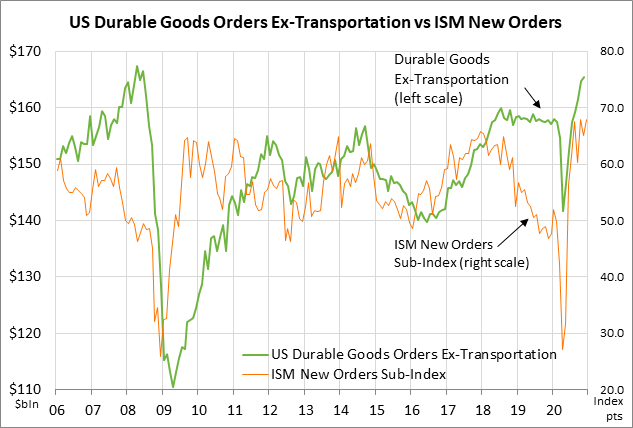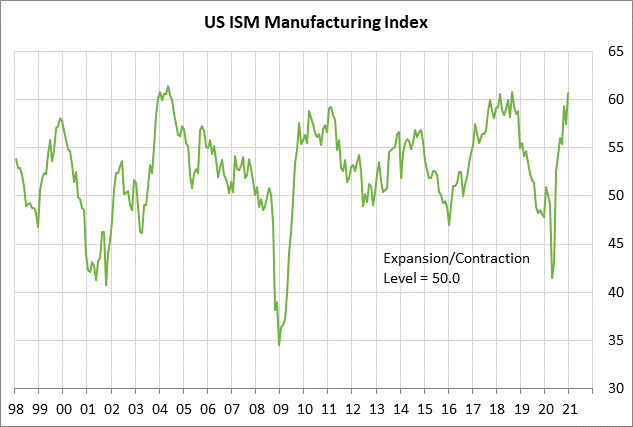- Powell expected to downplay QE tapering
- Odds are quickly dwindling for a bipartisan pandemic aid bill
- Durable goods orders expected to rise
Powell expected to downplay QE tapering — The market is unanimously expecting the FOMC at its 2-day meeting that concludes today to leave its main policy variables unchanged with the funds rate target at 0.00/0.25% and the QE program at $120 billion per month. The FOMC at this meeting will not update its macroeconomic forecasts or its forecast for the funds rate target.
This main issue for this week’s meeting will be the extent to which Fed Chair Powell, in his post-meeting press conference, tries to dampen market speculation about QE tapering. Several Fed officials earlier this month started talking about the timing of QE tapering, which sent T-note yields substantially higher.
However, other Fed officials and Mr. Powell himself finally stepped in to try to douse the QE tapering talk. On January 14, Mr. Powell said, “We’ll communicate very clearly to the public and we’ll do so, by the way, well in advance of active consideration of beginning a gradual taper of asset purchases.” Mr. Powell was essentially saying that the Fed will give the markets plenty of warning about when they have to start worrying about QE tapering.
The markets are not expecting the Fed to begin tapering its QE program until late this year at the earliest. A recent survey by Bloomberg found that only about one-quarter of respondents expect the Fed to begin tapering by the fourth quarter of this year. The survey found that 35% expect tapering to begin in Q1-2022, and the remainder expect tapering in Q2-2022 or later.
Interest rate hikes by the Fed are expected to come even later. The market is expecting the Fed to leave its funds rate target unchanged at least through late-2022, according to the federal funds futures market. According to the Eurodollar futures market, which trades farther out into the future than fed funds futures, the market is expecting the Fed’s first +25 bp rate hike by mid-2023 and is expecting an overall +175 bp rate hike to almost 2.00% by late 2029.
Meanwhile, there is already talk about the fact that Mr. Powell’s term as Fed Chair ends in a year in February 2022. A Bloomberg survey found that about three-quarters of respondents believe President Biden will reappoint Mr. Powell. The reappointment of Mr. Powell would be soothing since the markets would have some policy continuity and would not have to worry about any abrupt policy shifts.
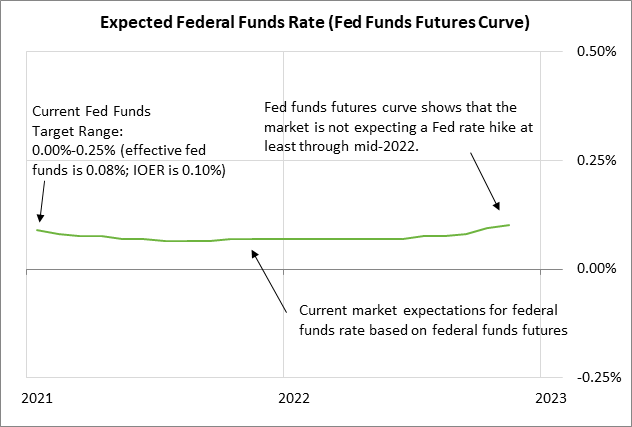
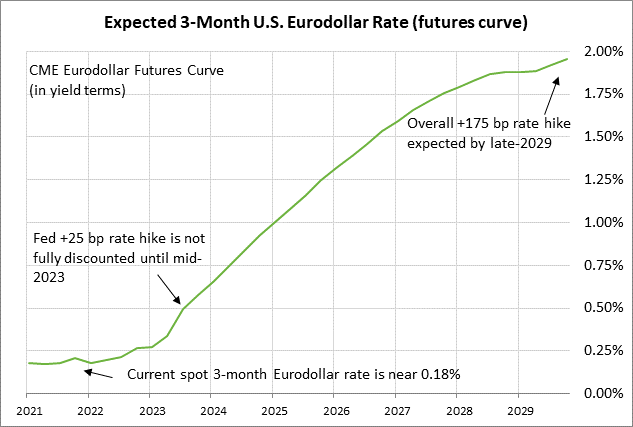
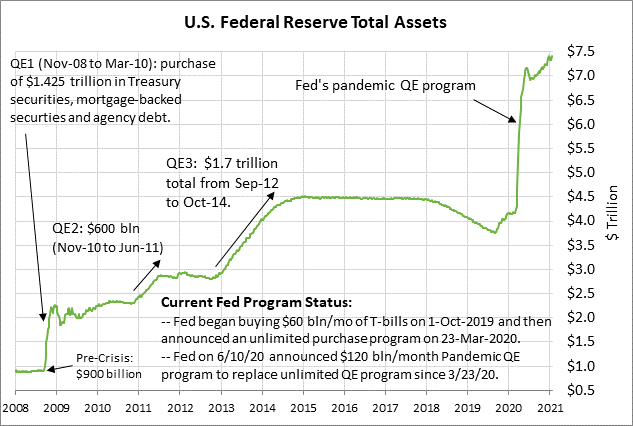
Odds are quickly dwindling for a bipartisan pandemic aid bill — Senate Majority Leader Schumer seems to have little hope for a bipartisan pandemic aid bill. Mr. Schumer said in an interview on Monday afternoon that he expects to use the budget reconciliation process twice this year, once for a pandemic bill and the second time for an infrastructure/clean energy stimulus bill.
Mr. Schumer yesterday became more specific and told his caucus to be ready for a vote as soon as next week on a 2021 budget resolution bill that would kick off the process of passing a pandemic aid bill through the budget reconciliation process.
Mr. Schumer said he is waiting to gauge the willingness of Republicans to cooperate on a bipartisan plan before deciding whether to move ahead with budget reconciliation. There is a bipartisan group of Senators who are discussing whether there is enough agreement to produce a bipartisan pandemic aid bill of any significance. However, any bipartisan bill is likely to fall far short of what Democrats are hoping for, thus encouraging Democrats to simply move ahead with their budget reconciliation bill.
The Democrats currently can pass only budget-related measures through the budget reconciliation process since the Republican’s filibuster power won’t be going away anytime soon. Democratic Senators Joe Manchin (WV) and Kyrsten Sinema (AZ) on Monday released statements saying they would not agree to eliminate the filibuster, meaning Republicans over the next two years will have the power to block any measures that don’t qualify for budget reconciliation. However, Republicans will have to be careful that they don’t anger Manchin-Sinema to the extent they finally decide to go along with the rest of the Democratic Senators and eliminate the filibuster.
As a result of the Manchin-Sinema statements, Senate Minority Leader McConnell late Monday said that he would finally agree to the organizing resolution and drop his demand for the protection of the filibuster.
Meanwhile, it became clear yesterday that the odds are nil that Mr. Trump will be convicted in his Senate impeachment trial that starts during the week of February 8. Only five Republicans yesterday voted on an amendment in a manner indicating they believe the trial is constitutional, implying that the other 45 Republican Senators are relying on the argument that a trial of an ex-president is not legitimate from a procedural standpoint and that they will therefore vote to acquit regardless of the substance of the charges. A conviction would require a two-thirds super-majority, consisting of 50 Democrats and at least 17 Republicans.
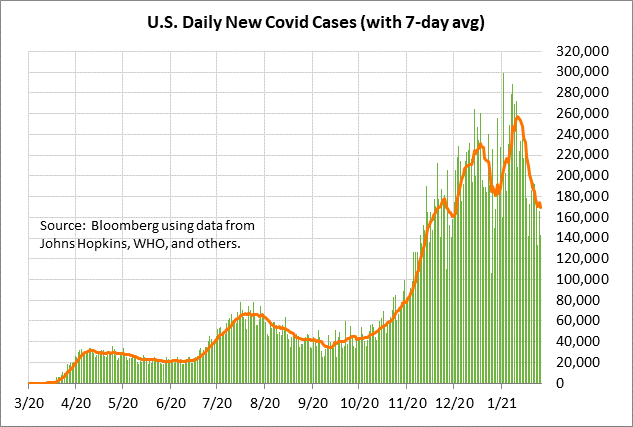
Durable goods orders expected to rise — The consensus is for today’s Dec durable goods orders report to show an increase of +1.0% m/m and +0.5% ex-transportation, adding to Nov’s report of +1.0% m/m and +0.4% m/m ex-transportation. Durable goods orders in Nov were up +3.9% y/y, a 1-3/4 year high, illustrating some good news for the U.S. manufacturing sector. Despite the surge in the pandemic, the ISM manufacturing index in December rose by +3.2 points to a 2-1/4 year high of 60.7, illustrating fairly strong manufacturing confidence.
